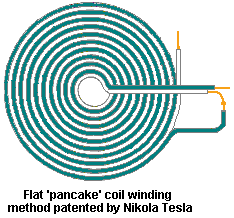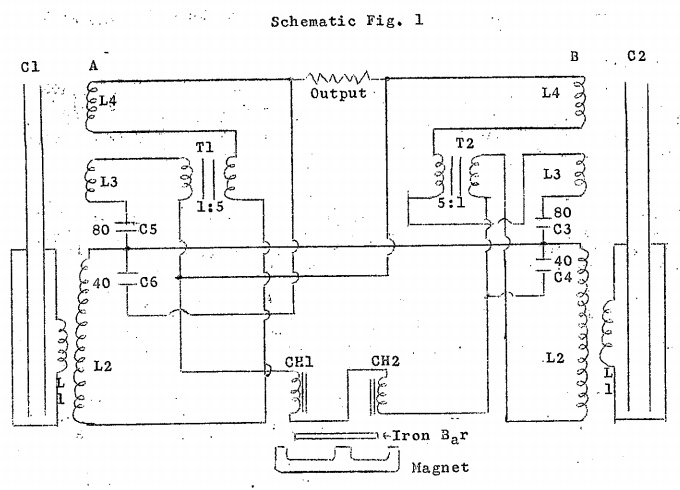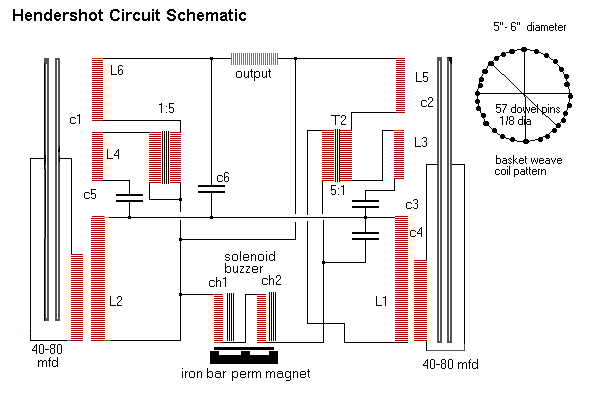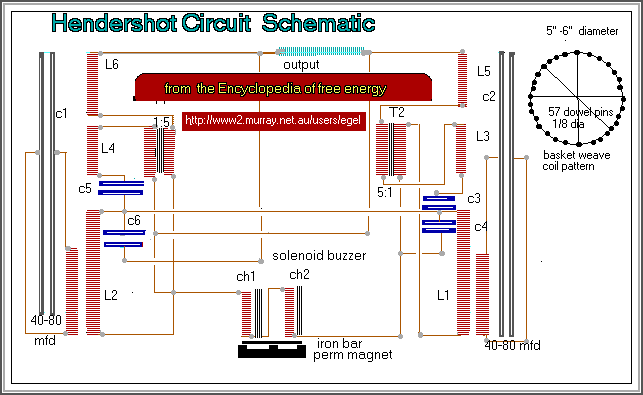updated 07-30-2014
In the late 1920s, Lester J. Hendershot built his Hendershot Generator, largely through simple trial and error. He wove together a number of flat coils of wire, and placed stainless steel rings and sticks of carbon, and experimented with permanent magnets in various positions. To his surprise, the device actually produced current. The generator raised considerable attention at the time.
“Fuelless Motor Impresses Experts”
New York Times (Sunday, February 26, 1928)
W.B. Stout Says, Invention Works Uncannily *** Washington Thinks It’s Important ~ Built On A Radio Principle ~ Armature Winding New — Invention Inspired By Young Son — Lindbergh Flies Here
Detroit, Mich, Feb. 25 — W.B. Stout, head of the Stout Air Lines and designer of the all-metal tri-motored Ford Monoplane, declared here today that he had seen what he characterized as an “impressive” demonstration of the Hendershot fuelless motor two weeks ago in Pittsburgh.
Lester J. Hendershot, the inventor, and his associate. D. Barr Peat, who is manager of the Bettis Field at McKeesport, demonstrated the motor secretly yesterday in a hangar at Selfridge Field. This block test was witnessed by Major Thomas G. Lanspier, Colonel Charles A. Lindbergh and others.
It was explained today that the model used in the demonstration was a much smaller machine than an actual working motor capable of developing enough power to lift and propel an airplane. Its designers claim for it that it runs on an electromagnetic principle, by which it draws its force directly from the earth’s field, and through the properties within the motor itself transforms these electric currents into power tha can be delivered efficiently at a propeller shaft.
Calls Demonstration Uncanny
“The demonstration was very impressive”, Mr. Stout said. “It was actually uncanny. I would like very much to see how a large model designed to develop power enough to lift an airplane would operate”.

Mr. Stout said the model he saw was about the size of the tiny motors used in vacuum cleaners. “I was told that the revolutionary feature was a hereto unknown manner of winding the armature”, [“He wove together a number of flat coils of wire”] Mr. Stout continued. “Hendershot said he had succeeded in winding it in such a way that it draws energy directly from electrical currents which exist constantly in the air or in the ground. Such sources of cheap and inexhaustible power, of course, never have been reached since Tesla. The small model appeared to operate exactly as Hendershot explained that it did”.
Neither Colonel Lindbergh nor Major Lanphier would express themselves at length on the test they witnessed yesterday. Major Lanphier admitted, however, that they were experimenting with it and referred all questions to Hendershot.
“He is the only one who knows all about it”, the Major said. “Lindbergh has nothing to do with it, although he saw it”.
William B. Mayo, chief engineer for the Ford Motor Company, was in conference with Major Lanphier, Hendershot and Peat at Major Lanphier’s quarters today.

“Invention Result Of Dream”
Hendershot Made First Fuelless Motor For His Son’s Toy Plane
The invention of the fuelless motor, tested at Detroit, was the result of a dream by its inventor, Lester Jennings Hendershot, who lives on “the street back of the railroad” in this town of about 3,000 inhabitants, 15 miles from Pittsburgh.
Although Hendershot was on his way from Selfridge Field today and is not expected home until tomorrow, his wife told of his conception of the machine and how the miniature model was constructed from the parts of a worn out radio which had been given to the inventor by his uncle.
Several years ago the vision of a machine which would operate from “earth currents” came to Hendershot in a dream, according to his wife, but it was not until last November that he actually started working on it.
His 4-year old boy had built a small airplane at that time and was considerably chagrined because it would not operate. The father was disturbed too, so he told his son he would build an airplane which would work. The result of that was the fuelless machine.
First Model Worked Toy Plane
When the miniature motor model had been constructed, Hendershot built a small airplane and placed the machine in it. A switch was turned and immediately the propeller began to move. The machie was not connected to any electrical current, but was running on is own accord from “earth currents”.
For several weeks the little motor and the airplane rested upon a small table in the living room of the Hendershot home, which faces an unpaved street near the railroad tracks. One day D. Barr Peat of Bettis Field, the air mail port near McKeesport, Pa., visited the Hendershot home to see the model.
He immediately became enthusiastic and a few weeks later he and Hendershot were at Selfridge Field where permission was been granted to build a model large enough to operate an airplane.
Hendershot, who is only 29 years old, was born in Hyndmann, Pa. His schooling has not been extensive, although he spent a few months several years ago at Cornell University, where he took a few courses in mechanics. He has not been employed at any particular task and has been known as a “freelance” worker. He has been a fireman and an engineer on the railroad, has worked in the mills near Pittsburgh, has inspected concrete and done electrical work. During the war he was a bugler with a machine gun company, but did not get overseas.
Still Wants To See “How They Work”
According to his mother, he has always been interested in mechanics and when a child he would insist upon taking his playthings apart.
And that desire has not escaped him a man, for even now he takes his own son’s playthings apart to “see how they work”.
It required only a few weeks for him to construct the miniature model of his fuelless motor, although he worked day and night during that time. He had a crude workbench in the cellar of his home, which was placed near the furnace, where it was warm. Early in the morning he would be there, tinkering about, and late at night he still could be found there.
Hendershot’s idea was that the earth currents which make the aurora borealis in the skies could be harnessed by man and made to produce power that would operate an engine.
The youthful inventor has no other inventions to his credit.
Hendershot’s fuelless motor works somewhat on the principle of a compass
“Works On Principle Of Compass”
Lester J. Hendershot first came to Bettis airplane field in McKeesport between two and three years ago, and soon afterward brought one of his motor models to the officers of the field for inspection.
The fuelless motor works somewhat on the principle of a compass, and the original model would always operate when pointing north or south, as does the compass, but would not move when pointed east or west.
Young Hendershot worked nearly two years to overcome this defect, and finally he brought a motor to the Bettis field that appeared to be working perfectly. This motor was installed in a small model airplane and the plane flew, but owing to the failure to rig it properly, it crashed to the ground during one of the experiments.
Constantly improving the motor, Hendershot finally interested D. Barr Peat, manager of the Bettis Field, in his invention.
After a short time several capitalist were interested, and a few weeks ago the motor was taken to Detroit by Hendershot and Peat for an exhibition.
While no person at the field was in position to say authoritatively, it was stated that the capitalists who become interested in the Hendershot motor have about completed their arrangements for the purchase of the invention, or for controlling its production.
The fuelless motor, it is said, appears to have tremendous power and easily made between 1500 and 2000 revolutions per minute on several occasions while being tested at the field. Pilots and mechanics believe it to be the greatest invention of the age, and all appear sure it will be a practical success as an airship motor.
It was stated at the field that the inspection of the motor by Colonel Lindbergh was made in the interests of the capitalists who were arranging to purchase the invention.

New York Times (February 27, 1928):
The Hendershot Fuelless Motor Is A Generator
The Hendershot “Fuelless motor” is not a motor at all but a generator, according to Major Thomas G. lanphier, commandant at Selfridge Field, Mich., where he with Lester J. Hendershot, the inventor, and D. Barr Peat, have been quietly working on an experimental model.
Major Lanphier said he first became interested in the Hendershot electrical machine several weeks ago through Peat; that in common with others he thought at first it was more or less “bunk” but after seeing it work he became interested.
“I saw the first model which Hendershot built hooked up to a small electric motor of the type used to operate a sewing machine. It not only ran the motor but it burned it out”, Major Lanphier said.
Why this generator acts as it does, where the energy comes from that transforms it into power, Major Lanphier was not prepared to say beyond quoting Hendershot. It is the inventor’s theory that his machine draws its energy from the earth’s magnetic field. While unwilling to describe it in detail until pending patents have been received, Major Lanphier told a little about it. The first model consisted of a ring magnet less than three inches in diameter. Around the magnet were coils rigged as only Hendershot knows how to rig them, and another set of coils pass through the center of the ring.
“With this contrivance we burned out the sewing machine motor and we also kept a 6 watt lamp going with it for 26 hours”, he said.
The larger model which has not yet been hooked to a motor that will deliver power to a crankshaft, Major Lanphier himself helped build. “We put it together out of stuff we picked up at the field and with it we lighted two 110 watt lamps”, Major Lanphier said. The second model is built around a ring magnet, the outside diameter of which is seven inches and the inside diameter six inches.
It was suggested that perhaps the Hendershot engine was “stealing” power from some big radio broadcasting station.
“We thought of that”, Lanphier said, “but we ran it for 26 hours when stations were going and when they were not and we got the same results”.

New York Times (November 12, 1928):
“May Seek Motor Patent”
Hendershot’s “magnetic induction” motor
M. C. Kelly to Ask Five Scientists to Test Hendershot Device
Representative M. Clyde Kelly of Pennsylvania, it became known here today, plans to seek a Congressional patent for the “fuelless” motor of Lester J. Hendershot of West Elizabeth, Pa., if five scientists approve the invention as practical. A Congressional patent gives the patentee full protection for 17 years.

Hendershot’s invention, which he describes as a “magnetic induction” motor, was first announced in March. At that time in some quarters it was regarded with skepticism.
The motor, according to its inventor, is without visible means of power. It obtains its initial impulse, Hendershot maintains, from a precharged magnetic core, and its secondary and greatest power impulse by magnetic induction from the earth.
Hendershot today said several of his motors had been built here, and that one, which developed 60 horsepower, had been in operation for two weeks without recharging the magnetic core.
New York Times (February 28, 1928):
Hendershot “Explains Magnet In Fuelless Motor”
Hendershot Says Shifting Its Field To east And West Causes Rotary Motion ~ Winding Of Magnet Secret ~
Inventor Asserts Engine Weighs But 4 Ounces Per Horsepower
Mildly indignant because the manner in which his fuelless motor gains its power had been misrepresented in dispatches from Detroit and Washington, Lester J. Hendershot today stated there was nothing mysterious about his motor, that the force that energizes it is the “same force that pulls the needle of the compass, and there is nothing mysterious about that”.
The fuelless motor was not his objective, he explained, at the time he began his experiments some three years ago, when he first became interested in aviation.
“I soon learned that the ultimate development o aviation depended upon the discovery or invention of an absolutely true and reliable compass”, he explained. “The ordinary magnetic compass does not point to the true north — it points to the magnetic north, and varies from the true north to a different extent at almost every point on the earth’s surface.
“There is another compass, the magnetic induction compass, that indicates true north. But it must be set before each flight, and is not always reliable.
“I found that with a pre-magnetized core I could set up a magnetic field that would indicate true north, but I didn’t know just how to utilize that in the compass I set out to find.
“In continuing my experiments, I learned that by cutting the same line of magnetic force north and south, I had an indicator of the true north, and that by cutting the magnetic field east and west, I could develop a rotary motion.
I now have a motor built on that principle that will rotate at a constant speed, a speed predetermined when the motor is built. It can be built for any desired speed, and a reliable constant speed motor is one of the greatest needs of aviation.
The main secret of Mr. Hendershot’s invention, his Friend Barr Peat declares, is the method of winding a magnet in the motor so that it will rotate in the opposite direction than the earth revolves. He says there is no heat, because magnetic forces are cold and the motor is stopped only by breaking the magnetic field in the windings. The magnet in the motor, he thinks, probably would have to be recharged after about 2000 hours of operation.
Mr. Hendershot declares that one of his motors, complete and ready to be installed in an airplane would weigh little more than four ounces for every horsepower it developed, while the best of the gas engines now built weighs about two pounds per horsepower.
Mr. Hendershot says that altitude would not affect the efficient operation of his motor, for the magnetic influence of the earth has been found to remain the same as high as man has ever reached.
He said that the same principle which made his original model operate only when it was placed in one direction, north and south, will be developed so that it will provide a compass that will always indicate true north.

His life threatened
on 9 March 1928, the same paper’s Washington correspondent reported that Hendershot was lying in serious condition in the District of Columbia’s Emergency Hospital, where he had been taken after receiving a severe electric shock from his motor while demonstrating it to patent attorneys.
After his recovery, Hendershot disappeared from public view for more than thirty years, resurfacing only once in 1945, when he sent a letter to the Free Press from the Standard Ship Company’s U. S. Navy Office in San Pedro, California. The letter accused scientists who had earlier belittled his efforts of now repeating his statements word for word. At the end of 1960, Hendershot’s device, now called a “magnatronic generator,” became the object of a research grant proposal made to the U. S. Navy’s Office of Naval Research.
The submission was made by Force Research, a group of some twenty Californians who, to quote the proposal, were,
“united in one centrally administered body to correlate their findings on experiments and problems which otherwise have been unsolved.”
Organized by Lloyd E.Cannon, a retired department head at the Weyerhauser Lumber Company, it included the controller of Capitol Records in Hollywood, the owner of the Precision Tool and Clock Company in Pasadena, an oil tycoon from Long Beach, a research engineer at the California Institute of Technology’s Jet Propulsion Labs in Sierra Madre, the president of McCaffrey Research Corporation in Palm Springs, and Dr. Daniel Fry, who a few years earlier had written about his incredible contact with an Unidentified Flying Object in his classic, The White Sands Incident.
Fry was to be project manager, Hendershot project engineer, for the development of the magnatronic generator for which the group sought $150,000 from the navy. The proposal provided the names of twenty-two persons (including businessmen, attorneys, contractors, publishers, and engineers) who had witnessed the generator in action, including a Colonel Lanphier, now retired.
The generator was reported to have lit a 100-watt lamp with “induced radio frequency energy. ” A Federal Communications Commission engineer who investigated the locale of the experiment told his superiors that he could find “no condition which could account for such a phenomenon,” and Bernard Linden, the engineer in charge of the FCC’s Los Angeles office, wrote to one of the experiment’s witnesses, Dr. Robert Fondiller, a New York engineer, for information on the apparatus used “when observing the above condition. ”
The Force Research project came to an end in 1961, when Lester Jennings Hendershot, his dream of providing the world with free energy still unrealized, committed suicide. One year before Hendershot’s death, a book, The Sea of Energy in Which the Earth Floats, was privately printed in Salt Lake City by its author, T. Henry Moray, Doctor of Electrical Engineering, who had earned his degree at the University of Uppsala in Sweden while on a stint as a missionary for the Mormon Church.
The book was Moray’s account of a nearly fifty-year-long, apparently successful effort to develop yet another collector of atmospheric energy. Also see www.rexresearch.com/moray2/morayrer.htm
The inventor states that he took first inspiration from a statement made by Tesla in an 1892 lecture:
“Ere many generations pass, our machinery win be driven by a power obtainable at any point of the universe. Throughout space there is energy. Is this energy static or kinetic? If static, our hopes are in vain; if kinetic – and this we know it is, for certain – then it is a mere question of time when men win succeed in attaching their machinery to the very wheelwork of nature.” – Nikola Tesla
A Few Magnet Motors
Alfred Hubbard’s Generator
Howard Johnson’s permanent Magnet Motor
Tesla, Radiant Energy, 1
The Francisco Pacheco Hydrogen Generator
Today
Alternatively, for detailed instructions on how to make your vehicle extremely fuel efficient ( to run your car on fumes ) see our page
Run your car on vapors


1-1/2 inch diam. in-line valve for $15
the T fitting: 1-1/2 inch diam. = $3
1-1/2 inch diam. vinyl tubing = $3/ft







Michael James Hendershot, It is amazing to see your perspective. Please, when you have a moment, contact me. I would love to have a chat over a cold cerveza.
Cheers
Very interesting to read about my father’s work… his device was useful in Cypress, Ca. in our home… there were many people who came to see it… at times dad had problems tuning it and it would frustrate him… I remember watching him use small c-clamps to put pressure on his coils… once he blew the capacitors up on to the ceiling in our dining room… there was always the smell of Paraffin Wax in our kitchen and the smell of fresh wires… we had some very interesting toys as kids things that we took for granted… I lost my father when I was 13 years old coming home with my brothers and sister to find him dead in the car we had in our back yard in 1961… some of the people who write about him have interesting information and some of it is false… Dad never got a patient. You couldn’t get a patient for what he was doing. It was free… in the air so to speak… I will always remember the racket it made as he tuned the sound away and the light came on… no one can take that away from me… the Government will never let you live off the Grid so to speak… it will be interesting if this even gets published…
Michael James Hendershot
It is impressive to hear from a relative, a son. We are pleased to hear from you.
It will be interesting if anything useful comes up to be published – like the instructions on how to build one – simple and specific enough that anyone can build it at home with wire and other cheap materials commonly available in stores. We have diagrams shown here, found on the internet but unfortunately vague without specific details.
It was always my dream to get it to work too as most of other guys tried. Schema reminded me couple of fragments from other sources but was never fully understood…until recently it was published by someone online with all details and explanations on how to get it to work not saying he also demonstrated live working video of the device with the only problem it’s in russian and need to be translated to english.
Working unit can be seen at: https://www.youtube.com/watch?v=HmYfcgvf6Jc along with other 5 videos on how to tune the unit with practical details. Can be found just click on the name, just recently published like last week may-9th 2016.
I’d suggest to download those videos before they’re removed – this is a real thing…
MikeB
here is a guide on how to build one…
https://www.youtube.com/watch?v=w3LRmSovEX8
Interesting but a bit complicated. . . . Alfred Hubbard’s design looks more promising.
… The elektricitet is so expensiv .Near a haff doller each kwh. send evry plan or video or some frends WHO have make One. Send my email to some One please. My job is a elektrisk man . Bless evry One . Thank
Bjarne Larsen Denmark
i need explanation ,as i tried and could not get it work
Do a google search but, there is just not enough information yet.
I see Lester Hendershot applied for a patent on his fuel less generator but did he ever get the patient? If he did what is the patent number?
In modern EE courses, Electromagnetism is barely explained in depth enough. They almost intentionally skim over it and all “generator” history as though it’s taboo!
It wasn’t until years after graduation and doing my own historical scientific research on how it was all invented did I discover there is all this suppression and mysterious energy left to experiment with, discover, utilize, and give access to the world!
It’s like each generation’s education in EE has been intentionally leaving out the many other patents and discoveries of Tesla and his successor’s in especially Radiant Energy!
USPO has never been any help to any RE inventor with their Political Agendas and intentions in keeping the citizen as a overworking-overspending-overtaxing slave for max profitting to the government or greedy corporate elites, who will do anything to shutdown any concept of harnessing free energy. You try and build a generator house from the stream in your back yard, and the EPA shuts it down. I am still surprised Gardens are allowed and aren’t shut down. Gardens are the “Free Food” of self-sufficiency, that can not be taxed or prices inflated. Much like mini hydrogenerators are the “Free Energy” of self-sufficiency, that can not be taxed or prices inflated or shouldn’t ever have to “buy a license” to use like the government “made it” when you made it.
Freeyourchains
Moray’s book is available for a free ebook printing at Google Books. Right away he talks about Tesla’s Radiant Energy and how he utilizes it in his inventions. For more evidence of this suppressed technology, I encourage the other readers to patent surf with Google’s Advanced Patent search technology.
Freeyourchains
i want this generator where can i buy it???
see our list of pages above and read our pages “Inventions, pg.1” and “inventions, pg.2” … and pay careful attention.
-ed.